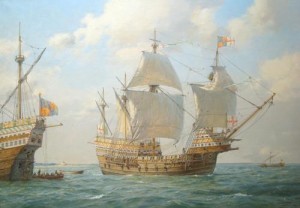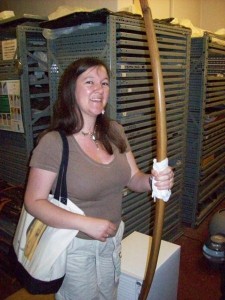
On this day in history, the 19th July 1545, Henry VIII’s flagship, the Mary Rose, sank right in front of his eyes in the Battle of the Solent between the English and French fleets.
We still do not know exactly why the Mary Rose sank, all we know for certain is that the English fleet moved out to attack the French fleet in the late afternoon of the 19th as “a fitful wit sprang up” and that something went wrong as the ship carried out a turning manoeuvre. The Mary Rose sank and along with her the majority of her crew, including Sir George Carew, the Captain.
But why did a ship whose illustrious career had started in 1512 sink to the bottom of the Solent on that fateful day in 1545? Well, there is still speculation over this question today with the following reasons being put forward:
- Her sinking was caused by a French hit – According to the French fleet, they hit her and she sank after they lured the English ships within range of their main fleet.
- She heeled over in the wind and water entered her gun ports – Van der Delft, the Imperial ambassador, told of how she sank, drowning just under 500 men, and how he “was told by a Fleming among the survivors that when she heeled over with the wind the water entered by the lowest row of gun ports which had been left open after firing.”
- Human Error – According to Sir Peter Carew, brother of the Vice Admiral of the Mary Rose, Sir George Carew, who died when the ship sank, his uncle Sir Gawain Carew had sailed past the Mary Rose as she began to heel and asked Sir George what was wrong. Sir George replied that “he had the sort of knaves whom he could not rule.” It was also Sir George Carew’s first naval command, so he was inexperienced.
- The Mary Rose had become unseaworthy – Some people believe that modifications over the years had added to the weight of the ship and made her unseaworthy.
You can read more about these theories and the arguments against them on the Mary Rose Trust page at https://maryrose.org/why-did-the-mary-rose-sink/.
The Raising of the Mary Rose
The Secretary of State in 1545, William Paget, ordered a salvage operation within days of the sinking but operations in 1545, 1547 and 1549 only managed to raise some guns and rigging. Nearly 300 years later, on the 16th June 1836, a fisherman snagged his gear on the wreck and John Deane, a diver exploring a nearby wreck, agreed to help the fisherman disentangle his gear in return for a half share of whatever the gear was caught up on. Dean found the Mary Rose and between 1836 and 1840 was able to recover a number of items including iron guns, bows and timbers. The ship, though, was left lying in her watery grave.

In 1979, The Mary Rose Trust was formed and an archaeological team led by Dr Margaret Rule CBE began to excavate the Mary Rose wreck. This culminated in the raising of the Mary Rose on 11th October 1982 by a team of Royal Engineers. The wreck was placed in a dry dock with a relative humidity of 95% and a temperature of 2-6ºC. A preservation programme then began in earnest.
On the 4th October 1983, just under a year after she was raised, the Mary Rose was put on public display in Portsmouth and a museum was created to display some of the artefacts found in the wreck. The Mary Rose is well worth a visit and you can find out more about visiting it at https://maryrose.org/.
Trivia: As the Mary Rose Trust points out, it is a myth that the ship was named after Henry VIII’s sister, Mary Tudor, Queen of France, and “It’s more likely the ship was named after the Virgin Mary, who was also known at the time as “The Mystic Rose”.” Mary Tudor was not known as “Mary Rose” either.
Also on this day in history
19th July 1553 – Mary I is proclaimed Queen. See “19 July 1553 – Mary I Proclaimed Queen” for details.